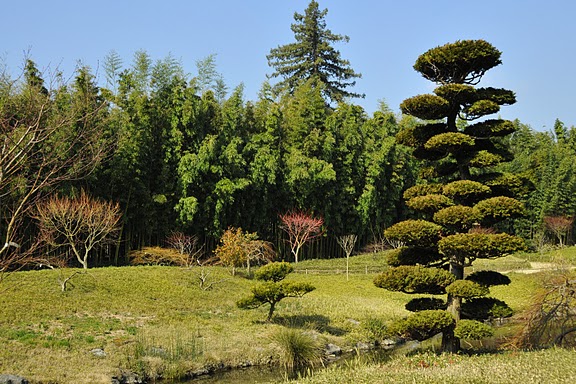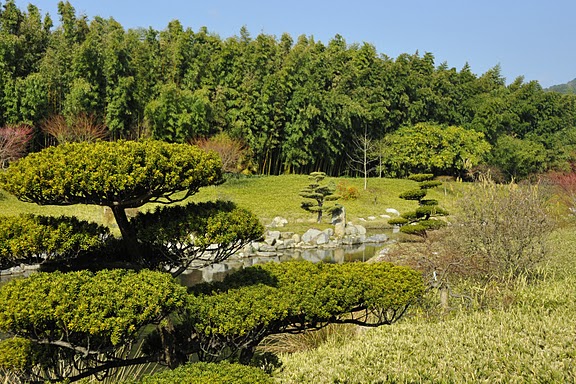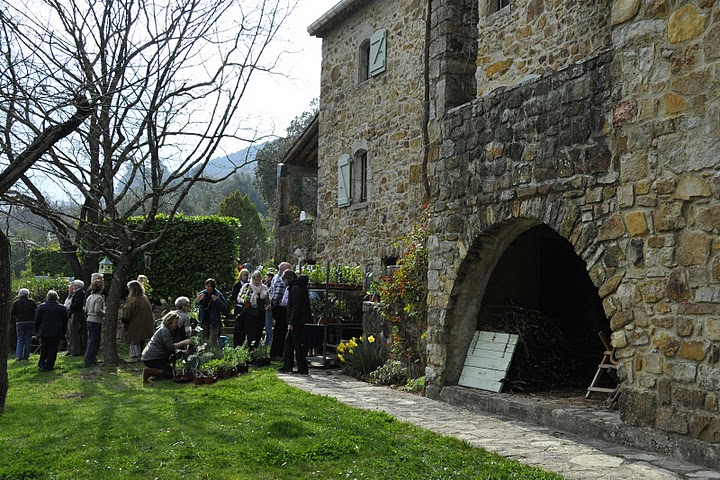March / mars 2011 – A visit to the Bambouseraie de Prafrance and a talk on jasmines
Une visite à la Bambouseraie de Prafrance et une causerie sur les jasmins
Click on the images to enlarge them / Cliquez sur les images pour les agrandir
Spring sunshine and a beautiful blue sky encouraged 37 members and guests out for the first visit of the season to the internationally renowned Bambouseraie de Prafrance, near Anduze.
Accompanied by Claire Martin de Foresta, Directrice Botanique et Scientifique, we were treated to an animated and informative tour of this magnificent and exotic park created in 1856 by the famous botanist Eugène Mazel. Few members had appreciated that bamboo is, in fact, a grass, grown from seed, and 90% of varieties grow in temperate climates and are very hardy, capable of withstanding temperatures down to -20ºC.
The location of the park was actually chosen for its cold microclimate, providing an ideal environment for the 200 species of bamboo which now flourish there.
We heard that bamboo is an extremely versatile plant used for building homes, scaffolding and household objects and, horticulturally, it is excellent for hedging and maintaining and stabilising embankments. Although in their native habitat some tropical species can grow to 40 metres, the bamboos in the park nevertheless attain a very impressive 23 metres. Invasiveness is an issue but with the right know-how the plant is containable and capable of eradication if necessary.
The park is approached by a breathtaking drive of 40 metre Sequoia sempervirens trees, interplanted with bamboos 14 metres high.
During our tour we saw other impressive trees planted when the park was first created including a mighty penduculate Quercus robur oak, a venerable Gingko biloba and one of the largest specimens of Magnolia grandiflora in Europe (the taxon is dedicated to Pierre Magnol, Directeur du Jardin des Plantes de Montpellier in the late 17th century). Everywhere we were dwarfed by the lofty trees, here a stand of Lawson cypresses smelling of lemongrass, there a group of palms reaching for the sky.
We wandered on through a delightful model Laotian village and then through the beautiful Valley of the Dragon created in 2000, the Year of the Dragon, and inspired by traditional Japanese art.
Back in the main house, dating from at least the 15th century and which survived both the catastrophic river Gardon floods here of 1938 and 2002, Claire explained the indispensable contribution of a herbarium to those involved in the study of plants. Herbiers allow scientists to note the characteristics of a particular plant gathered on a particular day and time from a particular place. She is working on upgrading the Bambouseraie’s own collection of samples, particularly of bamboos in flower, and this work can be accessed by searching on the web using the herbarium’s code: “BAMBO Générargues”. She hopes ultimately to create a collection of 5,000 specimens from all over the world.
Claire reminded us of the two international plant databases that are available, the botanical database of the Bioinformatics Department at Missouri Botanical Garden, which organises a vast number of plant specimens, images and bibliographic references, and IPNE the International Plant Names Index.
After the visit we enjoyed a delicious bring-and-share-a-dish-lunch at member Aline Rideau’s charming house with its magnificent views of the Cévennes.
In the afternoon, Mylène Bertetto, owner of a nursery specialising in climbing plants gave us a very helpful talk about just a few of the plants from her collection of jasmines.
We were surprised and delighted to hear of the versatility and hardiness of certain varieties including some which can survive to -25°C.
Seemingly there is a jasmine for almost any location however inhospitable and a visit to Mylène’s website, confirms this.
There is an illustrated summary of Mylène’s talk in the Plants Articles section.
Text: Sara Robinson
Photos: Hubert Nivière
![]()







